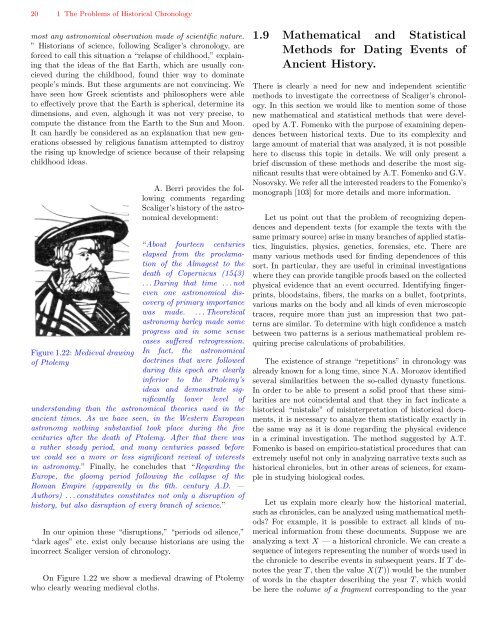mysteries of egyptian zodiacs - HiddenMysteries Information Central
mysteries of egyptian zodiacs - HiddenMysteries Information Central
mysteries of egyptian zodiacs - HiddenMysteries Information Central
Create successful ePaper yourself
Turn your PDF publications into a flip-book with our unique Google optimized e-Paper software.
20 1 The Problems <strong>of</strong> Historical Chronology<br />
most any astronomical observation made <strong>of</strong> scientific nature.<br />
” Historians <strong>of</strong> science, following Scaliger’s chronology, are<br />
forced to call this situation a “relapse <strong>of</strong> childhood,” explaining<br />
that the ideas <strong>of</strong> the flat Earth, which are usually concieved<br />
during the childhood, found thier way to dominate<br />
people’s minds. But these arguments are not convincing. We<br />
have seen how Greek scientists and philosophers were able<br />
to effectively prove that the Earth is spherical, determine its<br />
dimensions, and even, alghough it was not very precise, to<br />
compute the distance from the Earth to the Sun and Moon.<br />
It can hardly be considered as an explanation that new generations<br />
obsessed by religious fanatism attempted to distroy<br />
the rising up knowledge <strong>of</strong> science because <strong>of</strong> their relapsing<br />
childhood ideas.<br />
Figure 1.22: Medieval drawing<br />
<strong>of</strong> Ptolemy<br />
A. Berri provides the following<br />
comments regarding<br />
Scaliger’s history <strong>of</strong> the astronomical<br />
development:<br />
“About fourteen centuries<br />
elapsed from the proclamation<br />
<strong>of</strong> the Almagest to the<br />
death <strong>of</strong> Copernicus (1543)<br />
. . . During that time . . . not<br />
even one astronomical discovery<br />
<strong>of</strong> primary importance<br />
was made. . . . Theoretical<br />
astronomy barley made some<br />
progress and in some sense<br />
cases suffered retrogression.<br />
In fact, the astronomical<br />
doctrines that were followed<br />
during this epoch are clearly<br />
inferior to the Ptolemy’s<br />
ideas and demonstrate significantly<br />
lower level <strong>of</strong><br />
understanding than the astronomical theories used in the<br />
ancient times. As we have seen, in the Western European<br />
astronomy nothing substantial took place during the five<br />
centuries after the death <strong>of</strong> Ptolemy. After that there was<br />
a rather steady period, and many centuries passed before<br />
we could see a more or less significant revival <strong>of</strong> interests<br />
in astronomy.” Finally, he concludes that “Regarding the<br />
Europe, the gloomy period following the collapse <strong>of</strong> the<br />
Roman Empire (apparently in the 6th. century A.D. —<br />
Authors) . . . constitutes constitutes not only a disruption <strong>of</strong><br />
history, but also disruption <strong>of</strong> every branch <strong>of</strong> science.”<br />
In our opinion these “disruptions,” “periods od silence,”<br />
“dark ages” etc. exist only because historians are using the<br />
incorrect Scaliger version <strong>of</strong> chronology.<br />
On Figure 1.22 we show a medieval drawing <strong>of</strong> Ptolemy<br />
who clearly wearing medieval cloths.<br />
1.9 Mathematical and Statistical<br />
Methods for Dating Events <strong>of</strong><br />
Ancient History.<br />
There is clearly a need for new and independent scientific<br />
methods to investigate the correctness <strong>of</strong> Scaliger’s chronology.<br />
In this section we would like to mention some <strong>of</strong> those<br />
new mathematical and statistical methods that were developed<br />
by A.T. Fomenko with the purpose <strong>of</strong> examining dependences<br />
between historical texts. Due to its complexity and<br />
large amount <strong>of</strong> material that was analyzed, it is not possible<br />
here to discuss this topic in details. We will only present a<br />
brief discussion <strong>of</strong> these methods and describe the most significant<br />
results that were obtained by A.T. Fomenko and G.V.<br />
Nosovsky. We refer all the interested readers to the Fomenko’s<br />
monograph [103] for more details and more information.<br />
Let us point out that the problem <strong>of</strong> recognizing dependences<br />
and dependent texts (for example the texts with the<br />
same primary source) arise in many branches <strong>of</strong> applied statistics,<br />
linguistics, physics, genetics, forensics, etc. There are<br />
many various methods used for finding dependences <strong>of</strong> this<br />
sort. In particular, they are useful in criminal investigations<br />
where they can provide tangible pro<strong>of</strong>s based on the collected<br />
physical evidence that an event occurred. Identifying fingerprints,<br />
bloodstains, fibers, the marks on a bullet, footprints,<br />
various marks on the body and all kinds <strong>of</strong> even microscopic<br />
traces, require more than just an impression that two patterns<br />
are similar. To determine with high confidence a match<br />
between two patterns is a serious mathematical problem requiring<br />
precise calculations <strong>of</strong> probabilities.<br />
The existence <strong>of</strong> strange “repetitions” in chronology was<br />
already known for a long time, since N.A. Morozov identified<br />
several similarities between the so-called dynasty functions.<br />
In order to be able to present a solid pro<strong>of</strong> that these similarities<br />
are not coincidental and that they in fact indicate a<br />
historical “mistake” <strong>of</strong> misinterpretation <strong>of</strong> historical documents,<br />
it is necessary to analyze them statistically exactly in<br />
the same way as it is done regarding the physical evidence<br />
in a criminal investigation. The method suggested by A.T.<br />
Fomenko is based on empirico-statistical procedures that can<br />
extremely useful not only in analyzing narrative texts such as<br />
historical chronicles, but in other areas <strong>of</strong> sciences, for example<br />
in studying biological codes.<br />
Let us explain more clearly how the historical material,<br />
such as chronicles, can be analyzed using mathematical methods?<br />
For example, it is possible to extract all kinds <strong>of</strong> numerical<br />
information from these documents. Suppose we are<br />
analyzing a text X — a historical chronicle. We can create a<br />
sequence <strong>of</strong> integers representing the number <strong>of</strong> words used in<br />
the chronicle to describe events in subsequent years. If T denotes<br />
the year T , then the value X(T )) would be the number<br />
<strong>of</strong> words in the chapter describing the year T , which would<br />
be here the volume <strong>of</strong> a fragment corresponding to the year



